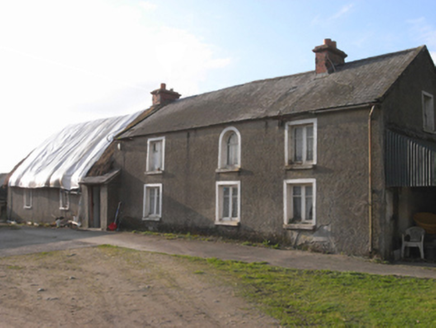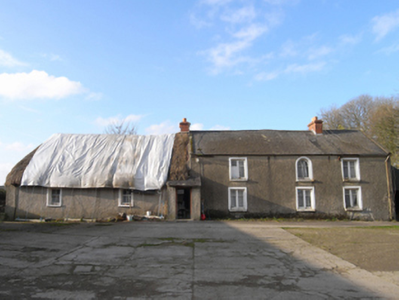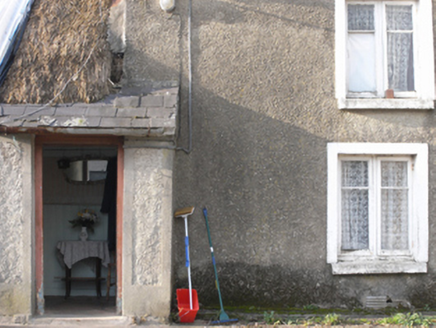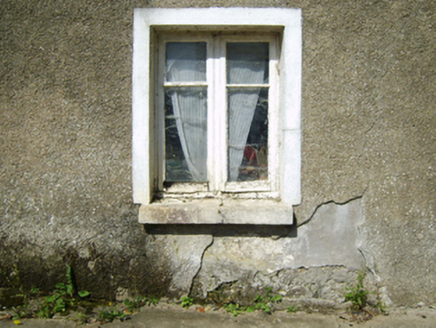Survey Data
Reg No
15612023
Rating
Regional
Categories of Special Interest
Architectural, Social
Original Use
Farm house
Date
1700 - 1840
Coordinates
303043, 149409
Date Recorded
08/06/2007
Date Updated
--/--/--
Description
Detached three-bay single-storey lobby entry thatched farmhouse with dormer attic, extant 1840, on a rectangular plan with single-bay single-storey lean-to windbreak abutting three-bay single-storey block with half-dormer attic. "Improved", pre-1904, producing present composition. Repaired, 1999. Now disused. Chicken wire-covered replacement hipped and pitched oat thatch roof (south) with degraded stretchers to ridge having exposed steel scallops, red brick Running bond dwarf chimney stack having stepped capping supporting terracotta pots, and remains of exposed bamboo stretchers to eaves having exposed steel scallops; pitched fibre-cement slate roof (north) with clay or terracotta ridge tiles, lichen-spotted rendered coping to gables, and remains of cast-iron rainwater goods on rendered eaves retaining cast-iron downpipes. Roughcast battered walls. Square-headed door opening with rendered "bas-relief" surround framing timber boarded door. Square-headed window openings (south) with concrete or rendered sills, and rendered "bas-relief" surrounds framing two-over-two timber sash windows having part exposed sash boxes. Square-headed window openings (north) centred on round- or segmental-headed window opening (first floor) with cut-granite sills, and rendered "bas-relief" surrounds framing timber casement windows. Set in own grounds perpendicular to road with rendered piers to perimeter having shallow pyramidal capping.
Appraisal
A farmhouse identified as an important component of the vernacular heritage of County Wexford by such attributes as the alignment perpendicular to the road; the lobby entry plan form; the construction in unrefined local materials displaying a battered silhouette with sections of "daub" or mud suggested by an entry in the "House and Building Return" Form of the National Census (NA 1901; NA 1911); the disproportionate bias of solid to void in the massing; and the high pitched roof showing a protected oat thatch finish (cf. 15700723; 15701608; 15702208; 15702220; 15703326; 15703330; 15703753; 15703757; 15704107): meanwhile, aspects of the composition clearly illustrate the continued linear development of the farmhouse in the later nineteenth century with those "improvements" showing a "permanent" slate finish (cf. 15703246; 15703251; 15704133). A prolonged period of unoccupancy notwithstanding, the elementary form and massing survive intact together with substantial quantities of the original fabric, both to the exterior and to the interior, thus upholding the character or integrity of the composition. Furthermore, adjacent "tin roofed" outbuildings (extant 1904) continue to contribute positively to the group and setting values of a neat self-contained ensemble making a pleasing visual statement in a rural street scene.







